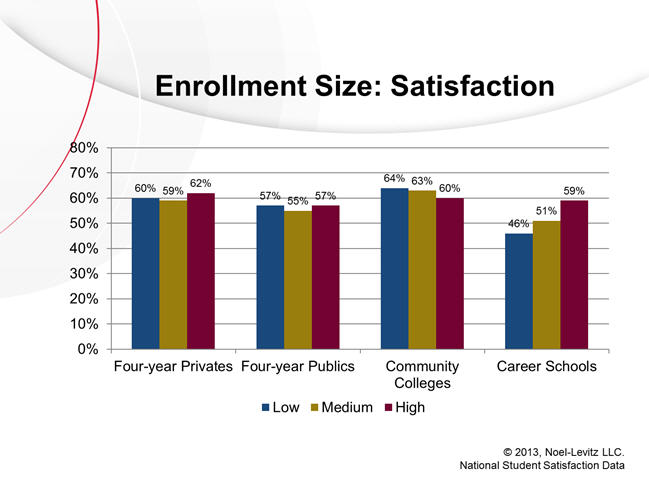enrollment
Does enrollment size have an impact on student satisfaction?
Does the number of students enrolled at an institution influence the satisfaction levels of those students? Colleges and universities certainly tout the benefits of enrollment size—smaller institutions in particular highlight class size and personal attention. But does it impact how students feel about their college experience?
This is the third in a series looking at the connection between student satisfaction and various institutional factors as defined by IPEDS. So far, we have looked at satisfaction and graduation rates along with satisfaction and tuition levels. What about the influence of the enrollment size of the institution? To answer this question, we looked at national data from the Student Satisfaction Inventory™ within the context of IPEDS data variables. We grouped schools into three categories based on these variables for enrollment size:
- Low—bottom 25 percent in size
- Medium—middle 50 percent
- High— top 25 percent
Here’s what we found:

At four-year institutions, satisfaction held steady across all enrollment groups, while community colleges had a slight decline as enrollment size grew. However, at career institutions, satisfaction jumped substantially with each enrollment tier. Altogether, these results go against the assumption that students at smaller institutions are inherently more satisfied than students at larger institutions.
In addition to looking at summary satisfaction scores, we also looked at the range in satisfaction scores for specific items.
Students at four-year privates and four-year publics were much more satisfied with the variety of courses that were available to them as the size of the institution increased. This is not surprising considering the perception that there are more options at larger institutions. Items related to concern for the individual decreased in satisfaction at both institution types as the size increased (financial aid staff, library staff, academic advisors, faculty, and administrators).
Students at community colleges were more dissatisfied with academic advising services and items regarding concern for the individual as the institution size increased. At two-year career schools, items regarding resources increased in satisfaction along with enrollment size, including computer labs and library resources being adequate.
I encourage you to consider what you know about your own levels of student satisfaction and consider them within this broader national context based on your own enrollment size. Are there areas where you may need to work harder at adjusting student perceptions about the experience that you are offering?
Read the full report
We have published the findings from these three blogs as well as additional details in our new report, The Relationship of Student Satisfaction to Key Indicators for Colleges and Universities. I encourage you to download the report, and please email me if you have questions about the findings or about conducting satisfaction surveys with your students.
